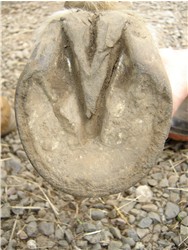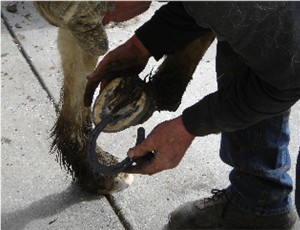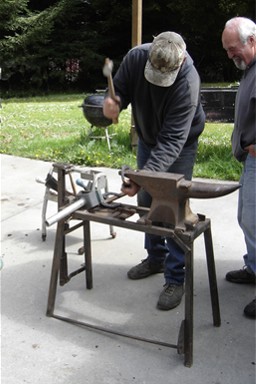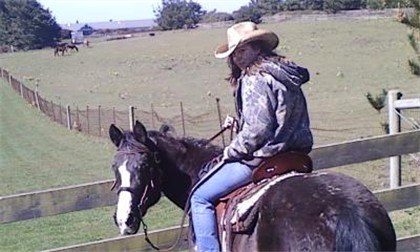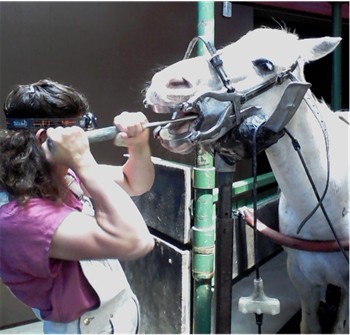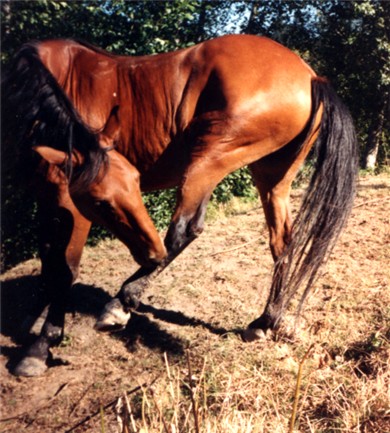Horse Hoof Care
and Common Hoof Problems
What about horse hoof care anyway? Find out what you need to know from trimming to common equine hoof problems and what to do about them.
Horses Hoofs Tell a Story
Cracked dry hoofs can indicate nutritional deficiencies. Hoofs with ringed ridges on the hoof show a horse has foundered. The more rings, the more chronic the equine founder. Pinched under slung heels point to navicular disease. Large horizontal breaks in the hoof wall are a sign of selenium toxicity. Hot hooves show laminitis or an abscess. Heat can also show fever in a sick or injured horse. A foul smell indicates thrush.
Horse Hoof Care for Healthy Feet
A horses foot grows about 1 inch every two months. Some grow faster, some a little slower. Most horses hoofs need trimming every 6-10 weeks, 8 weeks being the average. My mare, Hana, needs her hoofs trimmed every 6 weeks because her foot grows out fast.
A horse will need its hoofs trimmed about 6 times a year, every year, for the rest of his life, no matter if you are riding him or not.
With proper hoof care, horses can live a long productive life, 30 years or better. Whether you just have your horses feet trimmed or have them shod (have shoes put on your horse), it is essential that horses hooves are trimmed properly by a skilled farrier. Poor trimming and shoeing can cause temporary lameness or more permanent damage like navicular disease.
Wild horses never get their feet trimmed…..why should I trim my horses feet? When a wild horse has hoof problems, they go lame and get eaten by wolves. End of story.
Common Horse Hoof Problems
Consistency is Key:
It is so much easier to prevent hoof problems than it is to fix them.
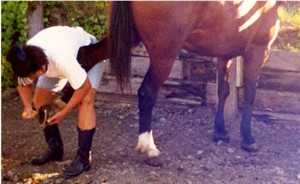
- Regular trimming/shoeing every 6-10 weeks
- Feed a consistent well balanced diet
- House horses on dry ground
- Don’t run on pavement
Responsible horsemen make a habit of picking their horses feet clean with a hoof pick before and after each ride. You’ll be removing any caked dirt and rock that can irritate the foot. This is your chance to spot any potential problems like loose shoes, stone bruises or any sign of potential trouble and act accordingly. This is just sound practice makes for good horse hoof care.
Stone bruises are caused by riding on rough ground without shoes or boots on your horse. They can also occur if the hoof is not picked clean with a hoof pick before and after a ride. Having a rock jammed up into the hoof…not good.
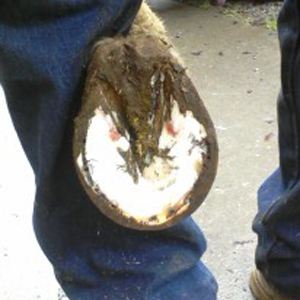 Stone bruises
Stone bruisesHoof abscesses are caused by tiny rocks and pebbles working their way up into the white line of the hoof. This can happen to shod or barefoot horses. Loose shoes are a trap for rocks and debris to get caught up between the hoof and shoe. You also run the risk of the horse pulling the shoe off and tearing chunks out of the hoof wall. Have a loose shoe pulled and replaced immediately.
Dry cracked hoofs, sometimes called quarter crack or sand crack, can be a signal of a nutritional deficiency or from stabling horses on sand. The sand will pull too much moisture from the hoofs. Horses stabled on sand are also at a greater risk of sand colic. If possible avoid excessive sand exposure and try adding a couple of tablespoons of vegetable oil to your horse’s grain.
Neglected hoof Vs. Healthy Hoof
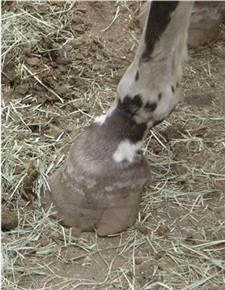 Neglected hoof
Neglected hoof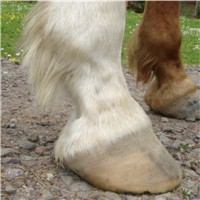 Healthy hoof
Healthy hoofJust like humans, horses benefit from essential oils for healthy nails and hair. You can also apply a horse hoof care moisturizer that doesn't contain alcohol or turpentine as these dry the hooves even more. I have seen good results with a product put out by Farnum called Rainmaker Triple Action Hoof Conditioner and Moisturizer. It will take several months to a year for the new healthy hoof wall to grow out and replace the old.
Running on hard surfaces, specifically pavement, will aggravate a cracked hoof and cause bone damage.
Thrush is a foul smelling bacterial infection on the underside of the horses hoof caused from standing in mud or filthy stalls. It affects the frog and surrounding areas. Black ‘dead’ tissue will crumble off when the hoof is picked. If left untreated, thrush can spread deeper into the tissue.
Here on the Northern California coast, we suffer a 6 month rainy season. Dry ground can be hard to find as everything turns to mud. I have found that a 50/50 mixture of bleach and water applied to the hoof twice a day with a spray bottle will kill most thrush bacterial infections. It's an inexpensive fix.
Chipped hooves can be avoided with regular trimming and good diet. Horse hoof care revolves around good shoeing/trimming, a good feed program, good housing conditions and diligent observation. When armed with knowledge; hoof problems, just like most equine diseases, can be prevented with regular consistent care.
Horses hoofs grow continuously, making horse hoof care a top priority. As the saying goes….”No hoof, no horse,”.....cliché yes, but so very true. Get the most out of your horse with good hoof care.
Horse Shoeing with Jarl Viale
For more insights on healthy feet, check out this informative interview with professional Farrier Jarl Viale.
Horse Hoof Anatomy
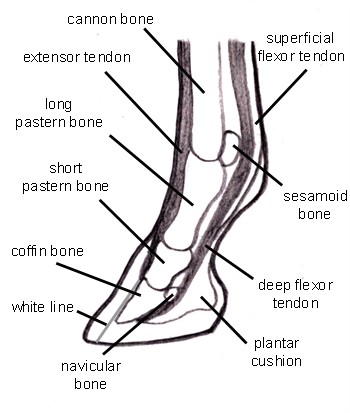
See horse hoof anatomy inside and out for a better understanding of your horse's feet.
True Horse Stories
Check out these fun true horse stories! Read about real life adventures on horseback.
Return to top of Horse Hoof Care page to easily access the navigation bar on the left for more at Equine Spot.
